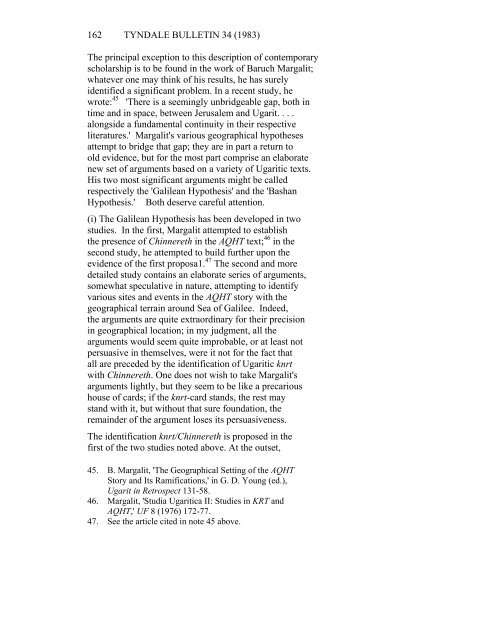UGARIT, CANAAN, AND ISRAEL.pdf - Tyndale House
UGARIT, CANAAN, AND ISRAEL.pdf - Tyndale House
UGARIT, CANAAN, AND ISRAEL.pdf - Tyndale House
Create successful ePaper yourself
Turn your PDF publications into a flip-book with our unique Google optimized e-Paper software.
162 TYNDALE BULLETIN 34 (1983)<br />
The principal exception to this description of contemporary<br />
scholarship is to be found in the work of Baruch Margalit;<br />
whatever one may think of his results, he has surely<br />
identified a significant problem. In a recent study, he<br />
wrote: 45 'There is a seemingly unbridgeable gap, both in<br />
time and in space, between Jerusalem and Ugarit. . . .<br />
alongside a fundamental continuity in their respective<br />
literatures.' Margalit's various geographical hypotheses<br />
attempt to bridge that gap; they are in part a return to<br />
old evidence, but for the most part comprise an elaborate<br />
new set of arguments based on a variety of Ugaritic texts.<br />
His two most significant arguments might be called<br />
respectively the 'Galilean Hypothesis' and the 'Bashan<br />
Hypothesis.' Both deserve careful attention.<br />
(i) The Galilean Hypothesis has been developed in two<br />
studies. In the first, Margalit attempted to establish<br />
the presence of Chinnereth in the AQHT text; 46 in the<br />
second study, he attempted to build further upon the<br />
evidence of the first proposa1. 47 The second and more<br />
detailed study contains an elaborate series of arguments,<br />
somewhat speculative in nature, attempting to identify<br />
various sites and events in the AQHT story with the<br />
geographical terrain around Sea of Galilee. Indeed,<br />
the arguments are quite extraordinary for their precision<br />
in geographical location; in my judgment, all the<br />
arguments would seem quite improbable, or at least not<br />
persuasive in themselves, were it not for the fact that<br />
all are preceded by the identification of Ugaritic knrt<br />
with Chinnereth. One does not wish to take Margalit's<br />
arguments lightly, but they seem to be like a precarious<br />
house of cards; if the knrt-card stands, the rest may<br />
stand with it, but without that sure foundation, the<br />
remainder of the argument loses its persuasiveness.<br />
The identification knrt/Chinnereth is proposed in the<br />
first of the two studies noted above. At the outset,<br />
45. B. Margalit, 'The Geographical Setting of the AQHT<br />
Story and Its Ramifications,' in G. D. Young (ed.),<br />
Ugarit in Retrospect 131-58.<br />
46. Margalit, 'Studia Ugaritica II: Studies in KRT and<br />
AQHT,' UF 8 (1976) 172-77.<br />
47. See the article cited in note 45 above.
















